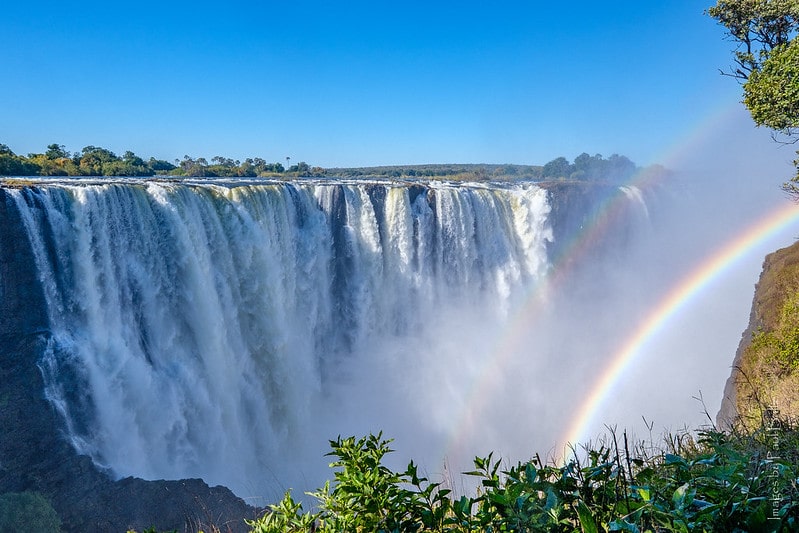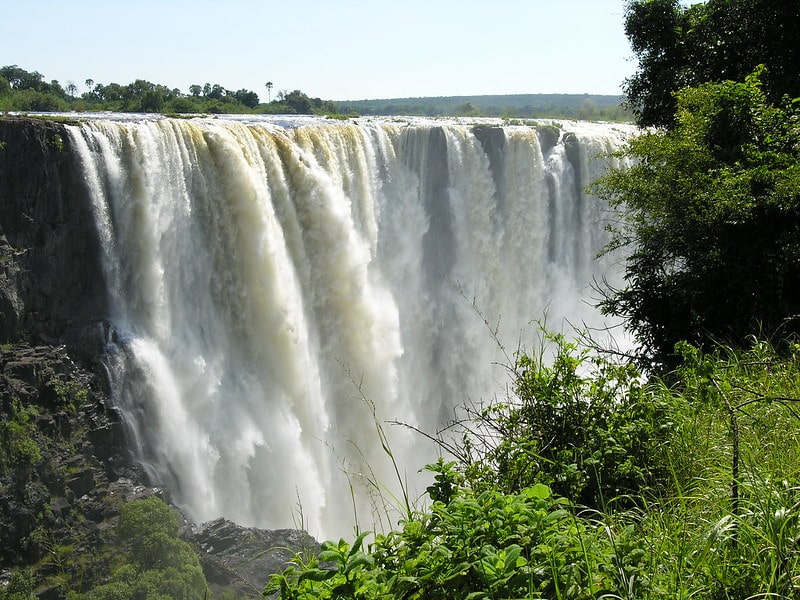Last updated on July 7th, 2021
Being in a category among the Seven Natural Wonders of the World, vacationing close to Victoria Falls can truly be a magical experience. In addition, it is an ideal destination for individuals in search of an active holiday. A number of ways are there to discover Victoria Falls and these include bungee jumping off the bridge, helicopter rides over the top, white water rafting and jet boating. For many visitors, a favorite way to explore Victoria Falls is via a sundowner cruise. This method facilitates seeing the legendary ‘moonbow.’ Victoria Falls is also widely viewed as an ideal honeymoon destination.
35 Facts About Victoria Falls
1. Location
Victoria Falls is located at the border of Zimbabwe and Zambia. Seventy-five percent can be viewed from the Zimbabwean side and 25 percent from the Zambian side. The best location for a face on view of the Falls is the Zimbabwean side.
2. Naming of the Falls
In 1855, the Falls was named for the British monarchy by David Livingstone, a British evangelist and explorer. However, African residents in the region referred to it as Mosi-oa-Tunya, which means ‘Smoke that Thunders.’ He was the first European to behold the grandeur of one of the incredible sights in Africa.

3. Language
The native Africans who reside around the Victoria Falls speak Bantu language as well as English and Portuguese.
4. Water Depth
At the base of the Falls, the depth of the water is 70 meters (229 feet).
5. Park Protection
Since 1983, the Zambezi National Park has been protecting the Victoria falls and since January 2013, the Victoria Falls National Park has been protecting it.
6. More Fall Dimensions
The Falls are 108 meters high and 1708 meters wide. Although known as the largest waterfall in the world, it is neither the widest nor the highest. However, it is the biggest curtain of cascading water on earth.
7. Width in the Wet Season
During the wet season, the width of Victoria Falls is a bit under 1 mile wide, which is 1609 meters.
8. Changes in Water Levels
Between September and December, water levels drop as the flow of the Zambezi decreases. This enables thrill seeker to swim to the edge of the Falls in a naturally-formed pool and view the chasm below.

9. The Chasm
The Victoria Falls waters do not plunge into an open basin but instead, they fall into a chasm that fluctuates in width between 25 to 75 meters or 80 and 240 feet.
10. The Formation of the Chasm
The precipice of the falls forms the chasm, along with a rock wall of the same height on the opposite side. The sole outlet of the chasm is a slender channel cut into some point of the barrier wall.
11. Character of Victoria Falls in the Rainy Season
The time of year greatly influences the character of the Falls. Just two islands emerge at the pinnacle of the falls during the rainy season: Livingston Island and Boaruka Island.
12. Character of Victoria Falls in the Dry Season
During the dry season, as there is a drop in the flow of the river, a number of more temporary islands will emerge.
13. Home of the “Moonbow”
At sunset on a full moon, the Falls provides a spectacular sight, as the moonlight bounces off the spray giving life to a ‘moonbow,’ which is basically a rainbow that lasts between sunset and sunrise.

14. More Than 5 Million Cubic Meters of Water Gush Over the Falls Every Minute
Throughout the wet season, the waters cascade into a gorge more than 100 meters deep. The gorge soar to the same height and has opposing cliffs made out of basalt.
15. The Falls Would be Non-existent Without the Zambezi River
The Falls make up a part of the 2574 kilometer stretch of the Zambezi and lie roughly halfway along the waterway. Then, the Zambezi leaves the Falls and head east towards the Indian Ocean.
16. High-volume Pool-drop River
Categorized as a high-volume pool-drop river, the Zambezi River offers great opportunities for enjoyment. Pool-drop is an indication that there is a minimal amount of exposed rock whether in the pools below the rapids or in the rapids themselves.
17. Located in Two National Parks
Victoria Falls is located in Mosi-Oa-Tunya National Park and maybe unsurprisingly, it is found in Victoria Falls National Park as well.
18. A Part of the Seven Wonders
As previously mentioned, the Falls in one of the Seven Natural Wonders of the World. It falls in this category among Parícutin, Mount Everest, the Grand Canyon, Aurora Borealis, the Harbour of Rio de Janeiro and the Great Barrier Reef.

19. Roaring Waters
As the water falls over the side of the cliff and cascade down into the Zambezi River underneath, it makes a roaring noise. A haze of water vapor can be seen around the Falls at all times.
20. Heavy Mist
While the falls are at their highest flow, the formation of the haze or heavy mist can completely obscure the base of the gorge and viewing from a lot of the edge is made challenging.
21. Thrill of the Mist
Sometimes, the mist can be as thrilling as the Falls. Typically, it escalates to more than 400 meters or 1300 feet and it can get to twice that height under certain conditions. Sometimes, the cloud that is formed can be viewed from as far away as 50 kilometers or 30 miles.
22. There are Many Gorges
The Falls feature several principle gorges that range between 120 and 240 meters or 400 and 800 feet deep and is among the intricate mysteries of nature. These are the Fifth, Fourth, Third, Second and First gorges, along with the Songwe Gorge.
23. All-day Rain at the Rainforest
The Victoria Falls Rainforest is located on the Zimbabwe side and it is the only place on planet where it rains every day of the year. This has resulted in lavish greenery in the forest.

24. Rainforest Plants
The rainforest has nurtured palms, figs, hanging vines and thick shrubs. It also has creepers, ferns on the floor of the forest and a remarkable range of rainforest flowers.
25. Notable Trees of the Rainforest
The red milkwood and two species of waterbooms (S. cordatum and Syzygium guineense) are the most essential tree species located in the rainforest. These trees are frequently found along the river over the Falls.
26. Fish Species
There are currently 75 known species of fish dwelling in the Zambezi River, with the most sought-after ones being the Tiger Fish. The Falls is a natural barrier separating them from the lower and upper sections of the river.
27. Birds of Victoria Falls
As a whole, the Victoria Falls region is home to more than 450 species of birds. This number includes a wide variety of waterbirds above the Falls along the river like the trumpeter hornbill, Heuglin’s robin and Knysna turaco.
28. Home to Many Wild Animals
The Falls is a natural habitat for animals like the buffalo, elephant, leopard, lion and white rhino, which are referred to as the “Big Five.” Crocodiles are also common in the area.
29. World Heritage Site
Victoria Falls was designated a World Heritage Site in 1989. This is an indication that it belongs to all peoples of the word, regardless of the country in which the World Heritage site is located.
30. Victoria Falls Bridge
Designed by London’s George Andrew Hobson, the construction of the bridge ended in 1905. It has a central arch that spans 500 feet and it is 650 feet long.
31. Railway and Hotel
Around the same time the bridge was built, the operation of the railway started and the Victoria Falls Hotel became open for business. This led to visitors using the train for transportation to the site of the Falls and staying in the comparative comfort of the hotel.
32. Boom in Tourism
Since the time of the establishment of the railway and hotel, tourism was significantly boosted and when the 20th century came to an end, over 300,000 visitors per year were coming to the location.
33. Stunning Views
The Falls and their lush surrounding area offer a dazzling range of wildlife viewing opportunities. These include wilderness habitats in the form of a variety of woodland and grassland habitats. These flank the river and are all just a short distance from the Victoria Falls themselves.
34. Safari Options
The site of the Victoria Falls offers its visitors a wide range of safari options. These include the Okavango Delta, Chobe River and the aprivi Swamps. It also has a cultural history that is rich and exciting.
35. White Water Rafting
White water rafting is facilitated in the Batoka Gorge underneath the Falls. Compared to other places across the globe, it is one of the craziest commercially-run water. At the put-in point, the Batoka Gorge is roughly 120 meters deep and at the take-out point, it is 230 meters.
